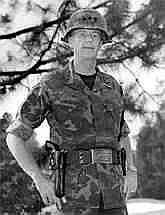Henry E. Emerson
| Henry E. Emerson | |
|---|---|
 | |
| Birth name | Henry Everett Emerson[1] |
| Nickname(s) | "Gunfighter", "Hank" |
| Born |
May 28, 1925 Washington, D.C., U.S.[1] |
| Died |
February 4, 2015 (aged 89) The Villages, Florida, U.S. |
| Buried at | Arlington National Cemetery, 12 August 2015 |
| Allegiance |
|
| Service/branch |
|
| Years of service | 1943–1977 |
| Rank |
|
| Commands held |
|
| Battles/wars | Vietnam War |
| Awards |
|
Henry Everett "Hank" Emerson (May 28, 1925 – February 4, 2015) was a United States Army lieutenant general best known for being the commander of the 2nd Infantry Division in South Korea[2] during the mid-1970s, when Colin Powell served as a battalion commander.[2][3] Emerson was a 1947 graduate of the United States Military Academy.
Career
Emerson gained recognition during the Vietnam War for his tactical ability on the battlefield. His tactics, as a commander were novel.[3] He conceived aerial reconnaissance and combat methods that were employed effectively against the Viet Cong. These included a checkerboard concept that involves small groups covering grid squares to seek out an enemy, jitterbug tactics which are complex maneuvers using helicopters to surround an enemy. To the unitiated this would seem jittery like the dance, and Eagle Flights which were helicopters loaded with local soldiers and flown in quickly to assist foreign troops in certain situations.[4][5] He demonstrated that American soldiers could effectively "out-guerrilla" the Viet Cong. Emerson also developed the "seal-and-pile-on technique" (the rapid build-up of combat power to surround and destroy an enemy force). These highly complex tactics shattered many large enemy units.

Emerson was known for his somewhat eccentric personality, from his training methods to carrying a cowboy-style revolver in place of a regulation M1911 semi-automatic pistol. He was a believer in reverse-cycle training, during which troops trained at night and slept during the day. He also required that they watch the television film Brian's Song, to promote racial harmony. Colin Powell, who would later go on to become a four-star general and the U.S. Secretary of State, has stated that they were very close and that what set Emerson apart was his great love of his soldiers and concern for their welfare. When Powell wrote his autobiography "My American Journey", he dedicated an entire chapter to Emerson. Powell said that Emerson's leadership philosophy was "if we don't do our jobs right Soldiers will not win". In many instances when he was the XVIII Airborne Corps commander he would turn in the tag numbers of excessively speeding vehicles. The next morning, the violator(s) would be escorted by the company and battalion commanders from their unit and a verbal reprimand would be delivered by the brigade commander.
Emerson suffered severe burns after his helicopter was shot down in the Mekong Delta.[6] He had commanded forces during the Vietnam War prior to being stationed in South Korea.[3] He later served as commander of the XVIII Airborne Corps and Fort Bragg, from July 1975 to June 1977. He died at the age of 89 on February 4, 2015.[7]
References
- 1 2 Jackson, Jonathan. "Senior Officer Oral History" (PDF). An Oral History of LTG Henry E. Emerson. U.S. Army Military History Institute. Retrieved February 15, 2013.
- 1 2 The Art of Command: Military Leadership from George Washington to Colin Powell, edited by Laver, Harry S. and Jeffrey J. Matthews, University Press of Kentucky, Lexington Kentucky (2009). LCCN 2008-28017
- 1 2 3 Chales, James R., The God Machine: From Boomerangs to Black Hawks: The Story of the Helicopter, Bantam Dell, New York (2007), ISBN 978-0-553-38352-2
- ↑ http://www.history.army.mil/books/Vietnam/Sharpen/ch06.htm
- ↑ http://blogs.denverpost.com/captured/2012/05/15/photographer-collection-horst-faas-vietnam/5689/
- ↑ "Army brigade head hurt in Viet air crash". Chicago Tribune. Tribune Company. August 29, 1968.
- ↑ http://www.legacy.com/obituaries/bostonglobe/obituary.aspx?pid=174082269
External links
| Wikimedia Commons has media related to Henry E. Emerson. |
- 9th Infantry Division: Old Reliables, edited by John Sperry, Turner Publishing Company, 2000, p. 35. ISBN 1563116081
- AARP interview with Colin Powell
- Profile on MilitaryTimes
- Authorized biography of General Hank Emerson at the U.S. Army Military Institute website